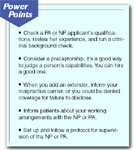Article
Extend your practice—not your liability
NPs and PAs can be a real boon to your practice. But watch for malpractice threats.

The extra attention PAs and NPs give to patients and their attention to the need for follow-up also makes for happier patients. And satisfied patients, conventional wisdom holds, are less litigious patients.
Having said that, extenders occasionally make mistakes, like anyone else. And in a malpractice suit, plaintiffs will typically sue the doctor as well. Charges are usually inadequate supervision or allowing the extender to work beyond her scope of practice and expertise.
What to do before an NP or PA comes onboard The best advice on limiting your liability is to hire carefully: Check your applicant's qualifications and credentials, review her job history and experience, and run a criminal background check. Have her work directly with you for the first several months so you can observe her methods and determine her level of competence.
One way to find a good candidate is to precept a PA or NP student, suggests Ellen Rathfon, director of professional affairs for the American Academy of Physician Assistants. If she's good, you can hire her. A local university that has an NP or PA program can match a student with your practice. Of course, "she'll need guidance, and you have to be available for consultations and assessments," says Jan Towers, a family NP and director of health policy with the American Academy of Nurse Practitioners.
When you add an NP or PA, inform your malpractice carrier right away, or you could be denied coverage for failure to disclose. Nonphysician providers often take out their own individual liability policies so they're protected if they change jobs or if you close your practice before a malpractice claim is filed. Still, "practices ought to consider purchasing separate medical malpractice insurance for the nurse practitioner," says Carolyn Buppert, an NP and attorney who specializes in reimbursement issues in Annapolis, MD. The cost is minimal: A $1 million/$3 million policy for an NP or PA working in a primary care practice generally costs less than $1,000 a year, she says.
Or, you could put the nonphysician provider on your corporate malpractice policy. John Marshall, director of healthcare risk services for the SilverStone Group, an insurance consulting firm in Omaha, NE, says the decision comes down to cost. "Higher limits, such as $2 million/$4 million plus an umbrella, may be sufficient without getting a separate policy."
And if your practice isn't already structured as a professional corporation, consider forming one in order to limit your personal liability, suggests Edward Hollowell, a Greenville, NC, attorney. If you go that route, most carriers will require separate policy limits for the corporation and each physician, and each nonphysician provider on staff increases your exposure, raising your corporate limit.
"I thought she was a 'real doctor'" Give your patients a written protocol explaining that your office uses physician extenders, and defining how often you must see patients who are seen routinely by a PA or NP. Your level of supervision depends on your state's regulations, but, for example, you might say that all new patients are seen by the physician, as are patients whose symptoms persist. Such a protocol can prevent a patient from claiming that he never knew he was being seen by anyone other than a "real" doctor.





